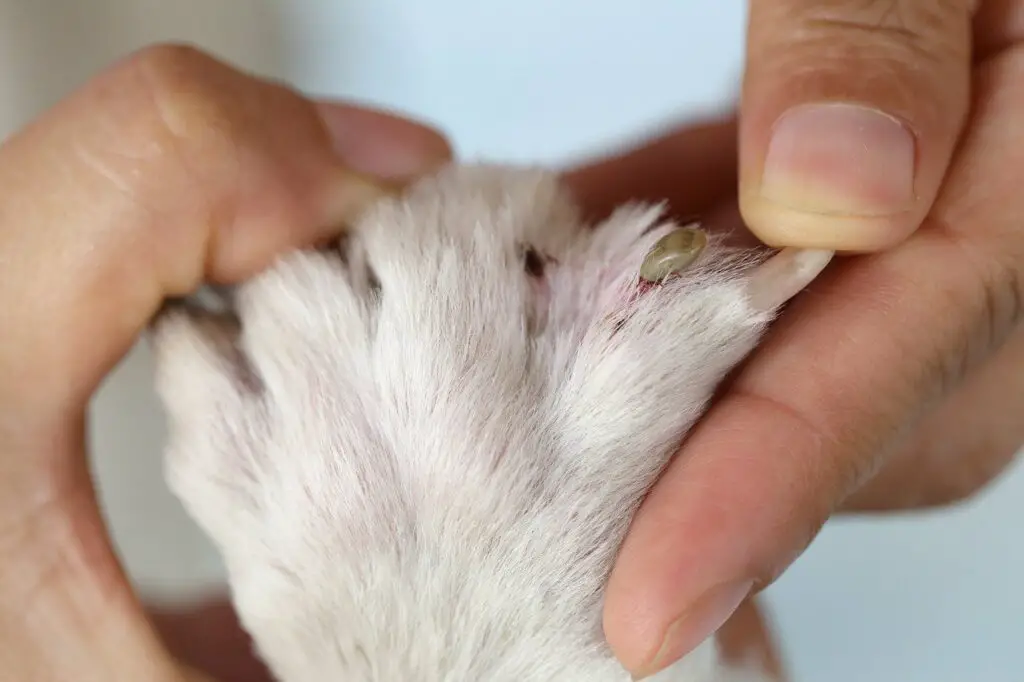Though tiny, fleas are mighty pests.
They’re not only a nuisance to you and your family but also transmit diseases to humans and animals.
If you have a pet, chances are you’ve had to deal with these pesky critters at some point.
All year long, you work to keep them away from your furry friend; but what happens when winter comes?
Does the cold weather kill fleas?
So, does frost kill fleas?
Frost can kill fleas, but temperatures must be cold enough for a sustained period.
For example, if your region has light frost or freezing temperatures for only a few hours, it’s unlikely that all the fleas will die.
However, several days or weeks of continuous freezing weather will kill adult fleas, larvae, and eggs.
In this article, we’ll discuss how cold weather affects fleas and what you can do to eliminate them in the winter.
We’ll also give you some tips on how to prevent fleas from invading your home in the first place.

Do Fleas Die In Freezing Weather?
During cold weather, fleas hibernate into a dormant state.
Thus, they slow down metabolism and heart rate.
They are less active in the winter and can survive for long periods without food.
Alternatively, they attach themselves to your pet and ride out in the winter.

How Different Life Stages of Fleas Cope with Frost
Although fleas can enter a dormant state to survive the cold, not all life stages can withstand freezing temperatures.
For example, eggs and larvae are more susceptible to frost than adult fleas.
The eggs and larvae will die within a few hours when exposed to extreme cold.
However, it’s important to note that low temperatures alone won’t kill fleas.
Eggs and larvae can survive below-freezing temperatures if protected from the cold.
For example, if fleas lay their eggs in a warm, sheltered area, the eggs will hatch, and the larvae develop into adult fleas.
To kill all stages of fleas, you need to lower the temperature and maintain it at a certain level for a sustained time.
For example, if the temperature outside is -15°C and you keep your home at 20°C, the fleas will survive.
However, if you lower the temperature inside your home to -15°C and maintain it for several days, all stages of fleas will die.
How to Get Rid of Fleas in the Cold Months
Now that you know fleas can survive the frost, you may be wondering how to get rid of them.
Treat your Pets
The first line of defense against fleas is to treat your pets.
If you have a dog or cat, ensure they’re up-to-date on their flea and tick prevention.
There are many different products on the market that are effective against fleas.
For instance, flea combs, baths, and trimming your pet’s fur are also helpful in removing fleas.
Clean your Home and Yard Area
Sanitation is key to preventing fleas.
Vacuum your floors and furniture regularly.
This will remove eggs, larvae, and adult fleas in your home.
Carpet and rugs should be removed, but if you can’t remove them, vacuum thoroughly, even the hard-to-reach areas.
Outside, trim your lawn and remove any debris or trash that may be present.
This eliminates potential hiding places for fleas.
Fleas are attracted to warm, humid areas.
Thus, if your yard is cluttered, it will provide a perfect environment for fleas to thrive.
Moreover, the places your pet frequents should be treated with an insecticide.
Air the Beddings
Changing your beddings, clothes, and towels is also essential; this prevents fleas from laying eggs in these areas.
If you have a pet that sleeps in your bed, consider investing in a flea-proof mattress cover.
Factors to Consider When Getting Rid of Fleas
- Fleas Reproduce Rapidly and Throughout the Year: Fleas are small, wingless insects that reproduce rapidly. A female flea lays up to 50 eggs per day and up to 2000 eggs in her lifetime. Moreover, fleas can breed year-round. Thus, if you detect even one flea, take action immediately.
- Fleas hide Anywhere: Eggs, larvae, and adult fleas can hide anywhere in your home. They’re often found in cracks and crevices, furniture, or beddings. For instance, fleas can fall off as your pet moves around your home and hide in carpet fibers or furniture.
- Ridding of Fleas takes Time: In most cases, eggs, pupae, or adult fleas can survive the first treatment. For example, if you spray, the fleas hide until the product dries. Then they’ll come out and resume their activities. Thus, being patient and consistent with your treatment plan is essential because flea larvae develop into adult fleas in about two weeks. Therefore, spray before they mature.
- Prevention is Key: Preventing an infestation is much easier than getting rid of fleas. The best way to prevent fleas is to treat your pets and clean your home. Vacuum regularly, change the bedding often, and trim your lawn. There are many different products on the market that are effective against fleas. Consult your veterinarian to find the best option for your pet and home.
How can I Tell if my Home has Fleas?
Fortunately, there are several signs that indicate a flea infestation:
Itchy and Scratchy Pets
Pets that are scratching or biting themselves more than usual may have fleas.
If you notice your pet scratching, check for fleas.
This is because fleas bite and feed on the blood of animals.
Thus, check for tiny black dots on your pet’s skin if you see your pet scratching.
The tiny black dots represent flea dirt comprising the host’s digested blood.
Flea Dirt
Flea dirt or droppings are small, black, and look like ground pepper.
This is because it’s composed of digested blood.
If you see flea dirt on your pet or home, fleas are likely present.
Flea Eggs and Larvae
You may also find tiny white eggs in your pet’s fur.
These are flea eggs that have yet to hatch.
You may also see small, translucent larvae crawling around.
These larvae feed on adult flea feces, which contain digested blood.
If you see either of these signs, your pet likely has fleas.
Flea Bites
Flea bites are small, red, and itchy.
They often appear in clusters or lines.
If you have these bites, there are likely fleas in your home.
Does Frost Kill Fleas FAQs
Can Dogs Get Fleas in Winter?
Dogs can get fleas in winter, but it’s less common than in warmer months.
This is because fleas are more active when the temperature is between 70° and 80°F.
However, if your dog spends time outdoors or in a kennel with other dogs, he can still contract fleas.
Can Fleas Survive Temperatures Below Zero?
All stages of fleas can survive temperatures below zero; this is because fleas are cold-blooded insects.
They rely on the temperature of their environment to regulate their body temperature.
How Long Do Fleas Live in Cold Weather?
Fleas can live for several weeks in cold weather.
However, they’re less active when the temperature is below 60°F.
This means they’re less likely to bite humans or animals.
Conclusion
Fleas are resilient pests that can survive in both hot and cold weather.
If you have a flea infestation, it’s crucial to take action immediately.
The best way to prevent an infestation is to clean your home and treat your pets regularly.
There are many different products on the market that are effective against fleas.
Consult your veterinarian to find the best option for your pet.
- What Dog Breeds Have Pink Skin? - March 24, 2023
- What Are the Most Inspiring Dog Breeding Quotes? - March 20, 2023
- Can Pheromone Spray Help Improve Dog Breeding Results? - March 19, 2023








